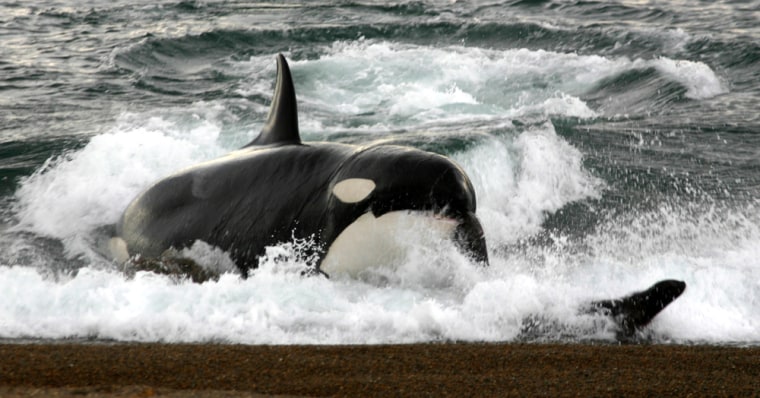Hunting on land is a rare occurrence, in which a killer whale seems to defy its instincts by leaving the sea, risking death if it becomes stranded on the inhospitable beach.

In a rare shot from March 25, a killer whale speeds straight toward the beach before launching itself onto the sand to hunt baby sea lions in Argentina’s Patagonian area of Punta Norte. Ho / ReutersApril 17, 2008, 10:19 PM +07 / Source: ReutersBy Damian Wroclavsky
A six-ton orca, or killer whale, torpedoes toward the beach, its dorsal fin cutting the Patagonian sea. It launches itself onto the sand in an explosion of water and foam.
Before the waters die down, the orca is shaking its immense head from side to side with a sea lion pup clamped between his jaws.
Then the orca wriggles into position to catch a wave to carry it back out to sea.
This is a rare occurrence, in which a whale seems to defy its instincts by coming onto land, risking death if it becomes stranded on the inhospitable beach.

Only seven orcas in the world are known to hunt this way, all of them members of a pod that patrols the coast of Patagonia’s Valdes Peninsula at this time of year. It happens almost exclusively in March and April — early autumn in the southern hemisphere — when baby sea lions are learning to swim.
One of the favorite hunting spots is at Playa Punta Norte, the northern tip of the peninsula, where a deep channel leads up to the sand, passing between two rocky areas where sea lions breed.
The sea lion pups learn to swim by crossing the channel between the rocks. Once they can swim well, they are too fast and agile for the orca. But the youngest ones, who stay on the sand at water’s edge, are perfect prey.
The orcas can beach themselves several times a day, but this hunting method is risky. Whales can die if they remain out of water, so they have to time the waves and judge distances carefully.
They use sonar — orcas are members of the dolphin family — to hunt, and only beach themselves in high tide, on steep and pebbly beaches that help them roll back.

Apprentice killer Orcas are highly social and long-lived: females can live up to 80 years and males almost 60. But the pods grow slowly because orcas take at least 15 years to mature, the females have calves only every five years or so, and many of the calves die young.
“It’s a culture at risk,” Roberto Bubas, a ranger with 15 years of experience observing orcas in Patagonia, said of the hunting method, noting that of the seven, only five are teaching the technique to younger members of the pod.
Mel, the 30-foot (9-meter) male who caught the baby sea lion on the beach was shadowed by a smaller apprentice, who shared the spoils of the hunt and followed the big expert up near the sand, but did not dare to beach itself.
The orcas, sea lions and penguins attracted 340,000 tourists to the Valdes Peninsula last year, when 36 cruise ships made stops nearby, three times as many as in 2002.
“Tourism is growing and growing. It’s massive. What we’re trying to do is redistribute the tourists,” said Sergio Casin, Conservation Director for Protected Areas in the southern Argentine province of Chubut.
The government asks tour companies to spread their groups around the peninsula, where they watch penguins and whales from lookout points on cliffs. Walking on the beaches is prohibited in most of the peninsula’s 1 million acre (400,000 hectare) reserve.
“The problem is trying to control all the people who don’t know how to respect the animals on the beach,” said Juan Copello, whose family owns the land at Playa Punta Norte.
People like Copello who had owned land on the peninsula before it became a reserve are allowed to remain but must work with the government to protect wildlife.
“In places where people always went down to the beach the animals have moved on and sought quieter areas,” said Copello, who runs a small lodge and also observes whales for Punta Norte Orca Research, a group led by New Zealand researcher Ingrid Visser.
Only documentarians, researchers and some journalists are allowed access to the beach at Playa Punta Norte, and they must pay for the privilege. The money goes to the provincial government, which administers the reserve.
Casin, of the provincial government, said: “Taking a lot of people there would make the sea lions stampede, which would damage the (whale’s) food and the life of the sea lions themselves.”







